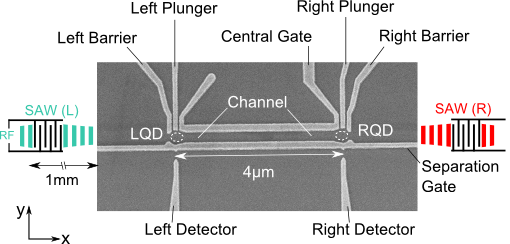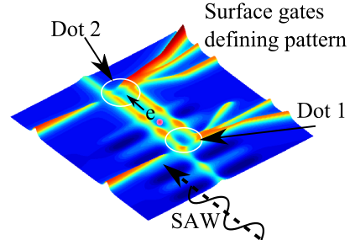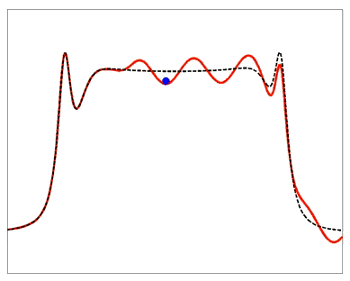Ping Pong with Electrons
September 23, 2011
The game,
ping-pong, also known as table tennis, has much to recommend it. The equipment is inexpensive, and the floor area required for play can be found in nearly every
household. The game has the potential for as much
physical activity as most other
sports, since the players are constantly running to and fro, waving their arms back and forth.
ping-pong also requires a great amount of skill in the
eye-hand coordination that's common in other ball sports. Ping-pong practitioners are skilled also in
physical mechanics, but at the subconscious level that's been practiced by humans throughout our existence. We wouldn't have survived as a
species if we didn't possess an innate knowledge of
ballistic trajectories, as for avoidance of fallen rocks and calculating the path of thrown
rocks,
spears and
arrows to our intended prey.
ping-pong also launched the
video game industry via
Pong, a popular
arcade video game that eventually became the selling point for home video game systems. The evolution of
computer graphics chips was driven in part by the need for faster and better
image rendering for arcade games. Much of this development was funded by me, one
quarter at a time, through my son.
Electrons behave differently depending on their host material. They can be tightly bonded to
atoms, as in most
ceramics, which are
electrically insulating as a consequence; they can be somewhat localized, as around a
dopant atom in a
semiconductor; or, they can roam the length and breadth of the solid, as for the highly conductive
metals. In our
nanotechnology age, it's possible to structure materials to influence electron state, as in the formation of
quantum dots.
A quantum dot, as its name implies, is a bit of material so small that
quantum effects are observed. A quantum dot can serve as a
potential well wherein an electron can be trapped. The electron can be released from the quantum dot when sufficient
energy is supplied.
Quantum dots can be formed in
gallium arsenide. Gallium arsenide also has the useful property that it is slightly
piezoelectric.[1]
Surface acoustic waves (SAWs) can be launched in piezoelectric materials, and SAW technology is useful for fabrication of the myriad
radio frequency filters that are found in
cellular telephones. In that case,
lithium niobate and
lithium tantalate, materials with a large piezoelectric effect, are used.
Scientists at the
Cavendish Laboratory of
Cambridge University and the
UK National Physical Laboratory (Teddington) have combined quantum dots and surface acoustic wave transducers on gallium arsenide to play electron ping-pong.[2-3] Their device is shown in the figure. Since the device is symmetric, with SAW transducers on each side, it's possible to shuttle the electrons from dot to dot in each direction.

Scanning electron micrograph of the electron ping-pong device. Voltages applied to conductor traces (light gray) create quantum dots, shown by the dashed circles. The dots are connected by 4 μm channel that assists in electron transport. Surface acoustic waves are generated by application of a microwave pulse to the left, or right, transducer. (Cambridge University Image).[4])
The gallium arsenide surface is sculpted to provide the required potential energy landscape that allows the ping-pong action. A careful energy balance is required, since the SAW wave provides just the slightest energy change. A potential energy map of the device in operation is shown in the figure. [4]

Illustration of the potential-energy landscape, as seen by an electron, and the potential wave produced by a surface acoustic wave traveling from bottom right, moving past the first dot, and then towards the second dot.
(Cambridge University Image). [4])
Investigation of the dependency of the process on the pulse width of the surface acoustic wave suggests that the process is achieved in just the first few acoustic wave cycles, about 20
nsec.[4] The research team was able to perform up to sixty faultless transfers, a distance of 0.25
mm, before glitches such as an electron's getting stuck in the transfer channel, or an extra electron's being dragged out of a quantum dot.[3-4] Changes in device geometry should solve these problems.

Still shot from an animation of the potential energies involved in the capturing of an electron from a quantum dot (right) by a surface acoustic wave and transferring it to a second dot (left).
(Cambridge University Animation, via YouTube))
Says team leader,
Chris Ford, of the Cavendish Laboratory
Semiconductor Physics Group,
"This is an enabling technology for quantum computers... There is a lot of work going on worldwide to make this new type of computer, which may solve certain complex problems much faster than classical computers. However, little effort has yet been put into connecting up different components, such as processor and memory."[2]
References:
- Supasarote Muensit, "Piezoelectric coefficients of gallium arsenide, gallium nitride and aluminium nitride," Thesis (PhD)--Macquarie University, School of Mathematics, Physics, Computing and Electronics, 1999.
- Genevieve Maul, "Scientists play ping-pong with single electrons," University of Cambridge Press Release, September 21, 2011.
- R. P. G. McNeil, M. Kataoka, C. J. B. Ford, C. H. W. Barnes, D. Anderson, G. A. C. Jones, I. Farrer and D. A. Ritchie, "On-demand single-electron transfer between distant quantum dots," Nature, vol. 477, no 7365 (September 22, 2011), pp 439–442.
- Playing ping-pong with single electrons, YouTube Video by Cambridge University Semiconductor Physics Group.
- Playing ping-pong with single electrons, Cambridge University Semiconductor Physics Group
Permanent Link to this article
Linked Keywords: Ping-pong; household; physical activity; sports; eye-hand coordination; physical mechanics; species; ballistic trajectories; rocks; spears; arrows; video game; Pong; arcade; computer graphics; chips; image rendering; quarter; electrons; atom; ceramic; electrically insulating; dopant atom; semiconductor; metal; nanotechnology age; quantum dot; quantum effect; potential well; energy; gallium arsenide; piezoelectric; surface acoustic wave; radio frequency; filter; cellular telephone; lithium niobate; lithium tantalate; scientist; Cavendish Laboratory; Cambridge University; UK National Physical Laboratory (Teddington); scanning electron micrograph; nanosecond; nsec; millimeter; mm; Chris Ford; Semiconductor Physics Group.